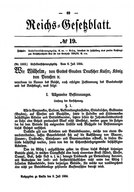
Unternavigation
Between 1883 and 1889, the German Reich introduced the obligatory health and accident insurance system as well as old age and disability insurance for workers and other wage earners. Soon, the new model of provision was also discussed and propagated in Switzerland. It marked the transition from social policy intended for welfare and the swift repair of damages to an expandable public service based on individual legal entitlements and social insurance that covered the risks of working life. Several factors tipped the scales in favor of the reforms initiated by Imperial Chancellor Otto von Bismarck: an interventionist understanding of the role of the state, problems with the existing assistance funds, unresolved questions regarding accident coverage and the intention of the government to integrate the working class into the authoritarian state and thus weaken social democracy.
The German health insurance (1883) included coverage of treatment costs, daily sickness allowance, and support for women in childbed and death benefits. The accident insurance (1884) likewise covered treatment costs and further provided for accident prevention measures. The old age and disability insurance (1889) granted a modest pension in the event of occupational disability or upon reaching the age of 70. All three insurance schemes were mandatory for people with an annual income of less than 2,000 Reichsmarks. They were funded by contributions from employees and employers, and additionally – in the case of old age and disability insurance – by state subsidies. The insurance schemes were either introduced on the basis of existing health insurance funds or new self-governing trade associations (accident insurance) and regional insurance institutions (old age and disability insurance) were set up.
Literatur / Bibliographie / Bibliografia / References: Lengwiler Martin (2007b), Transfer mit Grenzen: das ‚Modell Deutschland‘ in der schweizerischen Sozialstaatsgeschichte 1880–1950, in G. Kreis, R. Wecker (ed.), Deutsche und Deutschland aus Schweizer Perspektiven, 47–66, Basel; Stolleis Michael (2003), Geschichte des Sozialrechts in Deutschland, Stuttgart; Kott Sandrine (1995), L’état social allemand. Représentations et pratiques, Paris.
(12/2014)




